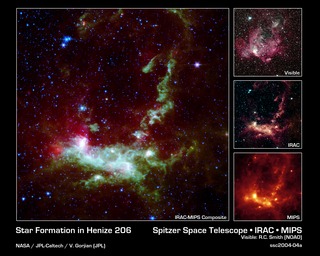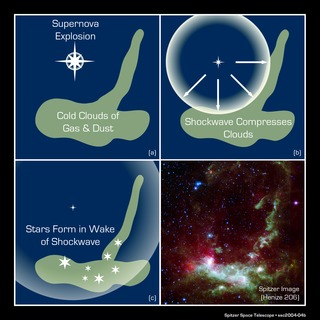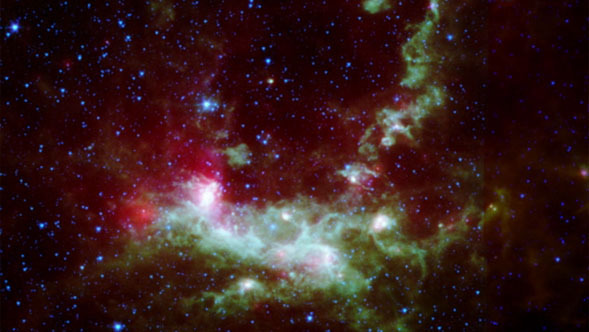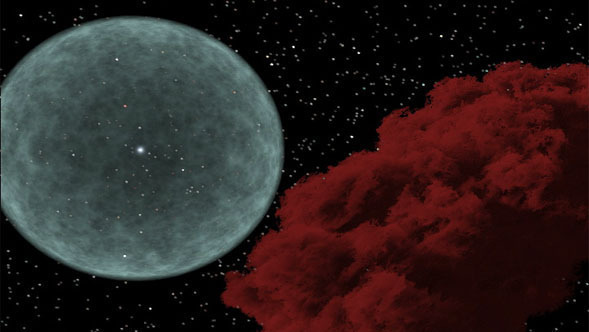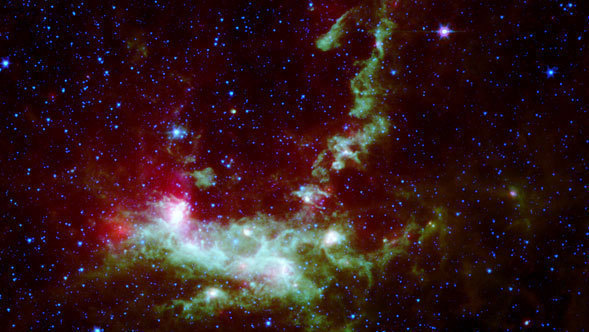
News Release • March 8th, 2004 • ssc2004-04 •
In a small nearby galaxy lies a luminous cloud of gas and dust, called a nebula, which houses a family of newborn stars. If not for the death of a massive star millions of years ago, this stellar nursery never would have formed.
The nebula, Henize 206, and the remnants of the exploding star that created it, are pictured in superb detail in a new image from NASA's Spitzer Space Telescope. Henize 206 sits just outside our own galaxy, the Milky Way, in a satellite galaxy 163,000 light-years away called the Large Magellanic Cloud. It is home to hundreds and possibly thousands of stars, ranging in age from two to 10 million years old.
"The image is a wonderful example of the cycle of birth and death that gives rise to stars throughout the universe," said Dr. Varoujan Gorjian, a scientist at NASA's Jet Propulsion Laboratory, Pasadena, Calif., and principal investigator for the latest observation.
As in other stellar nurseries, the stars in Henize 206 were created when a dying star, or supernova, exploded, shooting shock waves through clouds of cosmic gas and dust. The gas and dust were subsequently compressed, gravity kicked in, and stars were born. Eventually, some of the stars will die in a fiery blast, triggering another cycle of birth and death. This recycling of stellar dust and gas occurs across the universe. Earth's own Sun descended from multiple generations of stars.
The new Spitzer picture provides a detailed snapshot of this universal phenomenon. By imaging Henize 206 in the infrared, Spitzer was able to see through blankets of dust that dominate visible light views. The resulting false-color image shows embedded young stars as bright white spots, and surrounding gas and dust in blue, green and red. Also revealed is a ring of green gas, which is the wake of the ancient supernova's explosion.
"Before Spitzer, we were only seeing tantalizing hints of the newborn stars peeking through shrouds of dust," Gorjian said.
These observations provide astronomers with a laboratory for understanding the early universe, and stellar birth and death cycles. Unlike large galaxies, the Large Magellanic Cloud has a quirk. The gas permeating it contains roughly 20 to 50 percent of the heavier elements, such as iron, possessed by the Sun and gas clouds in the Milky Way. This low-metallicity state approximates the early universe, allowing astronomers to catch a glimpse of what stellar life was like billions of years ago, when heavy metals were scarce.
Henize 206 was first catalogued in the early 1950s by Dr. Karl Henize (pronounced Hen-eyes), an astronomer who became a NASA astronaut. He flew aboard the Challenger Space Shuttle in 1985. He died in 1993 at age 66 while climbing Mount Everest.
Launched on August 25, 2003, from Cape Canaveral, Fla., the Spitzer Space Telescope is the fourth of NASA's Great Observatories. The program includes the Hubble Space Telescope, Chandra X-ray Observatory and Compton Gamma Ray Observatory. JPL manages the Spitzer Space Telescope mission for NASA's Office of Space Science, Washington. Science operations are conducted at the Spitzer Science Center at the California Institute of Technology in Pasadena, which manages JPL.
News Media Contact
Whitney Clavin (626) 395-1877
Jet Propulsion Laboratory, Pasadena, Calif.
Donald Savage (202) 358-1547
NASA Headquarters, Washington, D.C.

